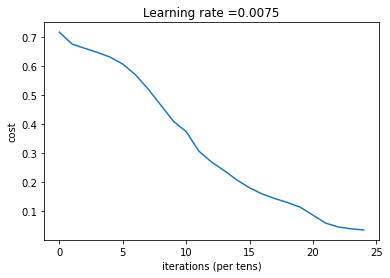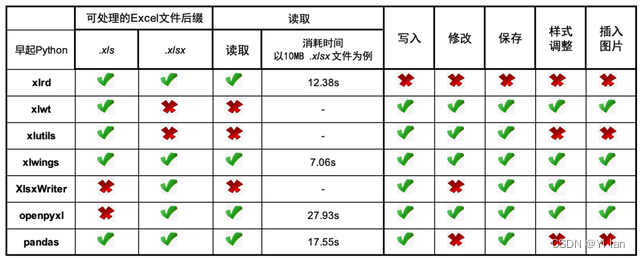声明
本文参考(8条消息) 【中文】【吴恩达课后编程作业】Course 1 - 神经网络和深度学习 - 第四周作业(1&2)_何宽的博客-CSDN博客
力求自己理解,刚刚走进深度学习希望可以一起探索。
本文所使用的资料已上传到百度网盘【点击下载】,提取码:xx1w,请在开始之前下载好所需资料,并将资料与代码放在相同界面
在正式开始之前,我们先来了解一下我们要做什么。在本次教程中,我们要构建两个神经网络,一个是构建两层的神经网络,一个是构建多层的神经网络,多层神经网络的层数可以自己定义。本次的教程的难度有所提升,但是我会力求深入简出。在这里,我们简单的讲一下难点,本文会提到**[LINEAR-> ACTIVATION]转发函数,比如我有一个多层的神经网络,结构是输入层->隐藏层->隐藏层->···->隐藏层->输出层**,在每一层中,我会首先计算Z = np.dot(W,A) + b,这叫做【linear_forward】,然后再计算A = relu(Z) 或者 A = sigmoid(Z),这叫做【linear_activation_forward】,合并起来就是这一层的计算方法,所以每一层的计算都有两个步骤,先是计算Z,再计算A
流程图

请注意,对于每个前向函数,都有一个相应的后向函数。 这就是为什么在我们的转发模块的每一步都会在cache中存储一些值,cache的值对计算梯度很有用,
在反向传播模块中,我们将使用cache来计算梯度。 现在我们正式开始分别构建两层神经网络和多层神经网络。这里很重要。
import numpy as np import h5py import matplotlib.pyplot as plt import testCases #参见资料包 from dnn_utils import sigmoid, sigmoid_backward, relu, relu_backward #参见资料包 import lr_utils #参见资料包
为了和我的数据匹配,你需要指定随机种子
np.random.seed(1)
对于一个两层的的神经网络而言,如下图
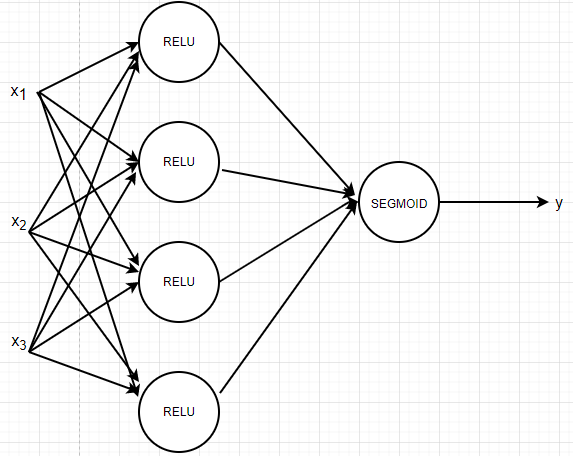
初始化参数如下
def initialize_parameters(n_x,n_h,n_y): """ 此函数是为了初始化两层网络参数而使用的函数。 参数: n_x - 输入层节点数量 n_h - 隐藏层节点数量 n_y - 输出层节点数量 返回: parameters - 包含你的参数的python字典: W1 - 权重矩阵,维度为(n_h,n_x) b1 - 偏向量,维度为(n_h,1) W2 - 权重矩阵,维度为(n_y,n_h) b2 - 偏向量,维度为(n_y,1) """ W1 = np.random.randn(n_h, n_x) * 0.01 b1 = np.zeros((n_h, 1)) W2 = np.random.randn(n_y, n_h) * 0.01 b2 = np.zeros((n_y, 1)) #使用断言确保我的数据格式是正确的 assert(W1.shape == (n_h, n_x)) assert(b1.shape == (n_h, 1)) assert(W2.shape == (n_y, n_h)) assert(b2.shape == (n_y, 1)) parameters = {"W1": W1, "b1": b1, "W2": W2, "b2": b2} return parameters
接下来,我们测试一下
print("==============测试initialize_parameters==============") parameters = initialize_parameters(3,2,1) print("W1 = " + str(parameters["W1"])) print("b1 = " + str(parameters["b1"])) print("W2 = " + str(parameters["W2"])) print("b2 = " + str(parameters["b2"]))
==============测试initialize_parameters============== W1 = [[ 0.01624345 -0.00611756 -0.00528172] [-0.01072969 0.00865408 -0.02301539]] b1 = [[0.] [0.]] W2 = [[ 0.01744812 -0.00761207]] b2 = [[0.]]
两层的神经网络测试已经完毕了,那么对于一个L层的神经网络而言呢?初始化会是什么样的?
当然我们在大学都学过矩阵的乘法和加法吧,我们来看代码
def initialize_parameters_deep(layers_dims): """ 此函数是为了初始化多层网络参数而使用的函数。 参数: layers_dims - 包含我们网络中每个图层的节点数量的列表 返回: parameters - 包含参数“W1”,“b1”,...,“WL”,“bL”的字典: W1 - 权重矩阵,维度为(layers_dims [1],layers_dims [1-1]) bl - 偏向量,维度为(layers_dims [1],1) """ np.random.seed(3) parameters = {} L = len(layers_dims) for l in range(1,L): parameters["W" + str(l)] = np.random.randn(layers_dims[l], layers_dims[l - 1]) / np.sqrt(layers_dims[l - 1]) # ➗这个根号其实和上面的✖0.01是一样目的的 parameters["b" + str(l)] = np.zeros((layers_dims[l], 1)) #确保我要的数据的格式是正确的 assert(parameters["W" + str(l)].shape == (layers_dims[l], layers_dims[l-1])) assert(parameters["b" + str(l)].shape == (layers_dims[l], 1)) return parameters
我们来测试一下
#测试initialize_parameters_deep print("==============测试initialize_parameters_deep==============") layers_dims = [5,4,3] parameters = initialize_parameters_deep(layers_dims) print("W1 = " + str(parameters["W1"])) print("b1 = " + str(parameters["b1"])) print("W2 = " + str(parameters["W2"])) print("b2 = " + str(parameters["b2"]))
==============测试initialize_parameters_deep============== W1 = [[ 0.79989897 0.19521314 0.04315498 -0.83337927 -0.12405178] [-0.15865304 -0.03700312 -0.28040323 -0.01959608 -0.21341839] [-0.58757818 0.39561516 0.39413741 0.76454432 0.02237573] [-0.18097724 -0.24389238 -0.69160568 0.43932807 -0.49241241]] b1 = [[0.] [0.] [0.] [0.]] W2 = [[-0.59252326 -0.10282495 0.74307418 0.11835813] [-0.51189257 -0.3564966 0.31262248 -0.08025668] [-0.38441818 -0.11501536 0.37252813 0.98805539]] b2 = [[0.] [0.] [0.]]
我们分别构建了两层和多层神经网络的初始化参数的函数,现在我们开始构建前向传播函数。
向前传播函数
- LINEAR
- LINEAR - >ACTIVATION,其中激活函数将会使用ReLU或Sigmoid。
- [LINEAR - > RELU] ×(L-1) - > LINEAR - > SIGMOID(整个模型)

线性部分【LINEAR】
前向传播中,线性部分计算如下:
def linear_forward(A,W,b): """ 实现前向传播的线性部分。 参数: A - 来自上一层(或输入数据)的激活,维度为(上一层的节点数量,示例的数量) W - 权重矩阵,numpy数组,维度为(当前图层的节点数量,前一图层的节点数量) b - 偏向量,numpy向量,维度为(当前图层节点数量,1) 返回: Z - 激活功能的输入,也称为预激活参数 cache - 一个包含“A”,“W”和“b”的字典,存储这些变量以有效地计算后向传递 """ Z = np.dot(W,A) + b assert(Z.shape == (W.shape[0],A.shape[1])) cache = (A,W,b) return Z,cache
我们来测试一下:
#测试linear_forward print("==============测试linear_forward==============") A,W,b = testCases.linear_forward_test_case() Z,linear_cache = linear_forward(A,W,b) print("Z = " + str(Z))
==============测试linear_forward============== Z = [[ 3.26295337 -1.23429987]]
线性激活部分【LINEAR - >ACTIVATION】
我们为了实现LINEAR->ACTIVATION这个步骤, 使用的公式是:A[l]=g(z[l])=g(W[l]A[l-1]+b[l]),其中,函数g会是sigmoid() 或者是 relu(),当然sigmoid()只在输出层使用,现在我们正式构建前向线性激活部分。
我们发现在同一层中A的序列号总是会少1。
def linear_activation_forward(A_prev,W,b,activation): """ 实现LINEAR-> ACTIVATION 这一层的前向传播 参数: A_prev - 来自上一层(或输入层)的激活,维度为(上一层的节点数量,示例数) W - 权重矩阵,numpy数组,维度为(当前层的节点数量,前一层的大小) b - 偏向量,numpy阵列,维度为(当前层的节点数量,1) activation - 选择在此层中使用的激活函数名,字符串类型,【"sigmoid" | "relu"】 返回: A - 激活函数的输出,也称为激活后的值 cache - 一个包含“linear_cache”和“activation_cache”的字典,我们需要存储它以有效地计算后向传递 """ if activation == "sigmoid": Z, linear_cache = linear_forward(A_prev, W, b) A, activation_cache = sigmoid(Z) elif activation == "relu": Z, linear_cache = linear_forward(A_prev, W, b) A, activation_cache = relu(Z) assert(A.shape == (W.shape[0],A_prev.shape[1])) cache = (linear_cache,activation_cache) return A,cache
我们来测试一下:
#测试linear_activation_forward print("==============测试linear_activation_forward==============") A_prev, W,b = testCases.linear_activation_forward_test_case() A, linear_activation_cache = linear_activation_forward(A_prev, W, b, activation = "sigmoid") print("sigmoid,A = " + str(A)) A, linear_activation_cache = linear_activation_forward(A_prev, W, b, activation = "relu") print("ReLU,A = " + str(A))
==============测试linear_activation_forward============== sigmoid,A = [[0.96890023 0.11013289]] ReLU,A = [[3.43896131 0. ]]
我们把两层模型需要的前向传播函数做完了,那多层网络模型的前向传播是怎样的呢?我们调用上面的那两个函数来实现它,为了在实现L层神经网络时更加方便,
我们需要一个函数来复制前一个函数(带有RELU的linear_activation_forward)L-1次,然后用一个带有SIGMOID的linear_activation_forward跟踪它,
我们来看一下它的结构是怎样的: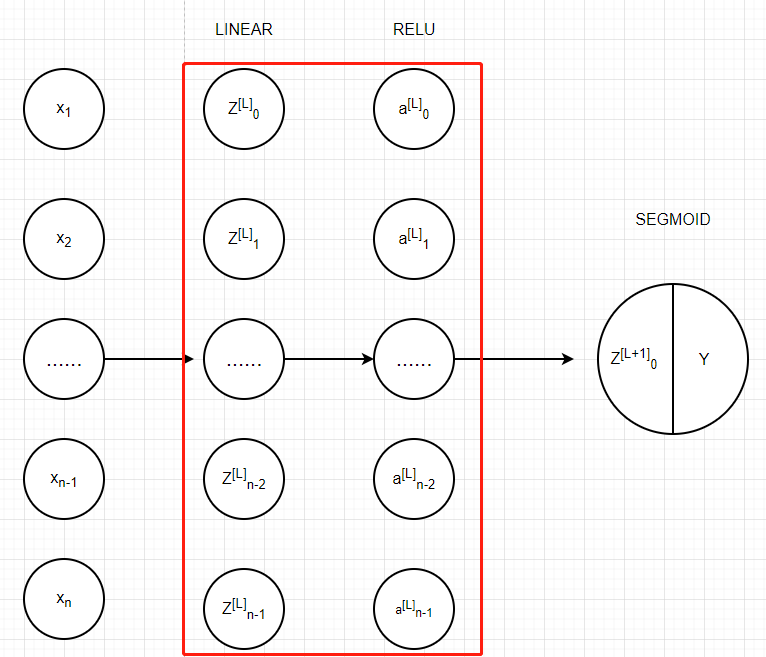
在下面的代码中,AL表示A[L]=g(Z[L])=g(W[L]A[L-1]+b[L]),(也可称作 Y_hat)
多层模型的前向传播计算模型代码如下:
def L_model_forward(X,parameters): """ 实现[LINEAR-> RELU] *(L-1) - > LINEAR-> SIGMOID计算前向传播,也就是多层网络的前向传播,为后面每一层都执行LINEAR和ACTIVATION 参数: X - 数据,numpy数组,维度为(输入节点数量,示例数) parameters - initialize_parameters_deep()的输出 返回: AL - 最后的激活值 caches - 包含以下内容的缓存列表: linear_relu_forward()的每个cache(有L-1个,索引为从0到L-2) linear_sigmoid_forward()的cache(只有一个,索引为L-1) """ caches = [] A = X L = len(parameters) // 2 # 因为有两个参数(W,b)因此要整除以2 for l in range(1,L): A_prev = A A, cache = linear_activation_forward(A_prev, parameters['W' + str(l)], parameters['b' + str(l)], "relu") caches.append(cache) AL, cache = linear_activation_forward(A, parameters['W' + str(L)], parameters['b' + str(L)], "sigmoid") caches.append(cache) assert(AL.shape == (1,X.shape[1])) return AL,caches
我们来测试一下:
#测试L_model_forward print("==============测试L_model_forward==============") X,parameters = testCases.L_model_forward_test_case() AL,caches = L_model_forward(X,parameters) print("AL = " + str(AL)) print("caches 的长度为 = " + str(len(caches)))
==============测试L_model_forward============== AL = [[0.17007265 0.2524272 ]] caches 的长度为 = 2
计算成本
我们已经把这两个模型的前向传播部分完成了,我们需要计算成本(误差),以确定它到底有没有在学习,成本的计算公式如:

def compute_cost(AL,Y): """ 上面定义的成本函数。 参数: AL - 与标签预测相对应的概率向量,维度为(1,示例数量) Y - 标签向量(例如:如果不是猫,则为0,如果是猫则为1),维度为(1,数量) 返回: cost - 交叉熵成本 """ m = Y.shape[1] cost = -np.sum(np.multiply(np.log(AL),Y) + np.multiply(np.log(1 - AL), 1 - Y)) / m cost = np.squeeze(cost) assert(cost.shape == ()) return cost
我们来测试一下:
#测试compute_cost print("==============测试compute_cost==============") Y,AL = testCases.compute_cost_test_case() print("cost = " + str(compute_cost(AL, Y)))
==============测试compute_cost============== cost = 0.414931599615397
我们已经把误差值计算出来了,现在开始进行反向传播
反向传播
反向传播用于计算相对于参数的损失函数的梯度,我们来看看向前和向后传播的流程图:
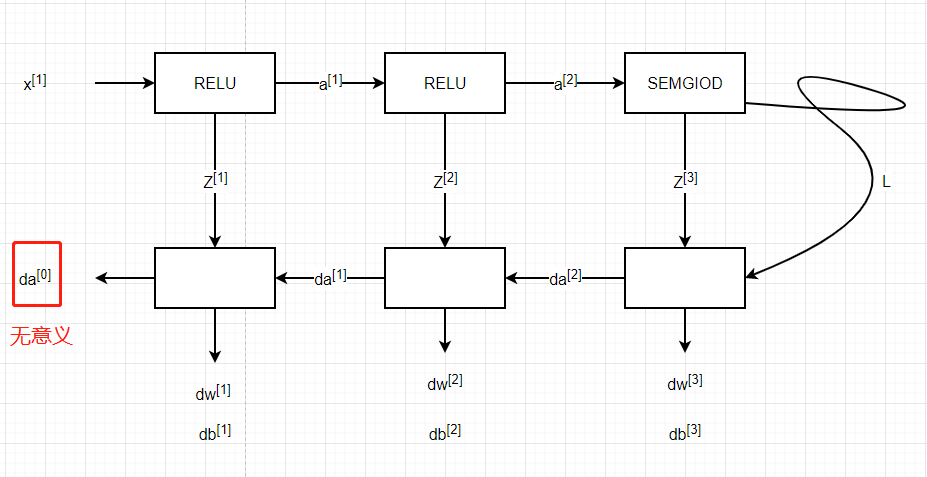
与前向传播类似,我们有需要使用三个步骤来构建反向传播:
LINEAR 后向计算
LINEAR -> ACTIVATION 后向计算,其中ACTIVATION 计算Relu或者Sigmoid 的结果
[LINEAR -> RELU] × \times× (L-1) -> LINEAR -> SIGMOID 后向计算 (整个模型)
线性部分【LINEAR backward】
我们来实现后向传播线性部分:
def linear_backward(dZ,cache): """ 为单层实现反向传播的线性部分(第L层) 参数: dZ - 相对于(当前第l层的)线性输出的成本梯度 cache - 来自当前层前向传播的值的元组(A_prev,W,b) 返回: dA_prev - 相对于激活(前一层l-1)的成本梯度,与A_prev维度相同 dW - 相对于W(当前层l)的成本梯度,与W的维度相同 db - 相对于b(当前层l)的成本梯度,与b维度相同 """ A_prev, W, b = cache m = A_prev.shape[1] dW = np.dot(dZ, A_prev.T) / m db = np.sum(dZ, axis=1, keepdims=True) / m dA_prev = np.dot(W.T, dZ) assert (dA_prev.shape == A_prev.shape) assert (dW.shape == W.shape) assert (db.shape == b.shape) return dA_prev, dW, db
我们来测试一下:
#测试linear_backward print("==============测试linear_backward==============") dZ, linear_cache = testCases.linear_backward_test_case() dA_prev, dW, db = linear_backward(dZ, linear_cache) print ("dA_prev = "+ str(dA_prev)) print ("dW = " + str(dW)) print ("db = " + str(db))
==============测试linear_backward============== dA_prev = [[ 0.51822968 -0.19517421] [-0.40506361 0.15255393] [ 2.37496825 -0.89445391]] dW = [[-0.10076895 1.40685096 1.64992505]] db = [[0.50629448]]
线性激活部分【LINEAR -> ACTIVATION backward】
如果 g ( . ) 是激活函数, 那么sigmoid_backward 和 relu_backward 这样计算:dZ[L]=dA[L]*g(Z[L])
我们先在正式开始实现后向线性激活:
def linear_activation_backward(dA,cache,activation="relu"): """ 实现LINEAR-> ACTIVATION层的后向传播。 参数: dA - 当前层l的激活后的梯度值 cache - 我们存储的用于有效计算反向传播的值的元组(值为linear_cache,activation_cache) activation - 要在此层中使用的激活函数名,字符串类型,【"sigmoid" | "relu"】 返回: dA_prev - 相对于激活(前一层l-1)的成本梯度值,与A_prev维度相同 dW - 相对于W(当前层l)的成本梯度值,与W的维度相同 db - 相对于b(当前层l)的成本梯度值,与b的维度相同 """ linear_cache, activation_cache = cache if activation == "relu": dZ = relu_backward(dA, activation_cache) dA_prev, dW, db = linear_backward(dZ, linear_cache) elif activation == "sigmoid": dZ = sigmoid_backward(dA, activation_cache) dA_prev, dW, db = linear_backward(dZ, linear_cache) return dA_prev,dW,db
下面我们来测试一下:
#测试linear_activation_backward print("==============测试linear_activation_backward==============") AL, linear_activation_cache = testCases.linear_activation_backward_test_case() dA_prev, dW, db = linear_activation_backward(AL, linear_activation_cache, activation = "sigmoid") print ("sigmoid:") print ("dA_prev = "+ str(dA_prev)) print ("dW = " + str(dW)) print ("db = " + str(db) + "\n") dA_prev, dW, db = linear_activation_backward(AL, linear_activation_cache, activation = "relu") print ("relu:") print ("dA_prev = "+ str(dA_prev)) print ("dW = " + str(dW)) print ("db = " + str(db))
==============测试linear_activation_backward============== sigmoid: dA_prev = [[ 0.11017994 0.01105339] [ 0.09466817 0.00949723] [-0.05743092 -0.00576154]] dW = [[ 0.10266786 0.09778551 -0.01968084]] db = [[-0.05729622]] relu: dA_prev = [[ 0.44090989 -0. ] [ 0.37883606 -0. ] [-0.2298228 0. ]] dW = [[ 0.44513824 0.37371418 -0.10478989]] db = [[-0.20837892]]
我们已经把两层模型的后向计算完成了,对于多层模型我们也需要这两个函数来完成,我们来看一下流程图:
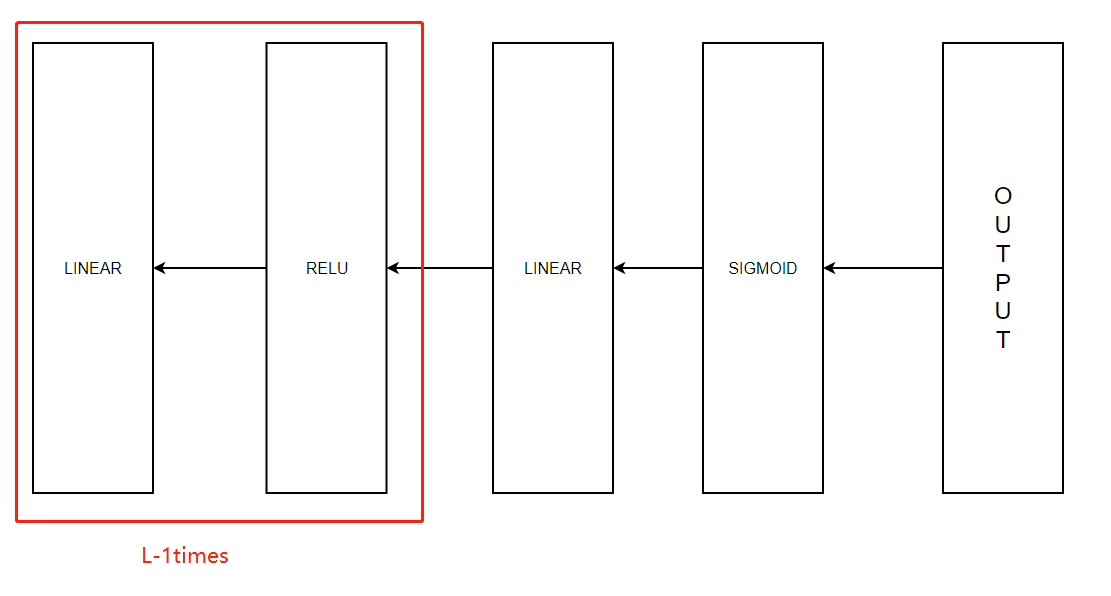
在之前的前向计算中,我们存储了一些包含包含(X,W,b和Z)的cache,我们将会使用它们来计算梯度值,
所以,在L层模型中,我们需要从L层遍历所有的隐藏层,在每一步中,我们需要使用那一层的cache值来进行反向传播。
我们开始构建多层模型向后传播函数:
def L_model_backward(AL,Y,caches): """ 对[LINEAR-> RELU] *(L-1) - > LINEAR - > SIGMOID组执行反向传播,就是多层网络的向后传播 参数: AL - 概率向量,正向传播的输出(L_model_forward()) Y - 标签向量(例如:如果不是猫,则为0,如果是猫则为1),维度为(1,数量) caches - 包含以下内容的cache列表: linear_activation_forward("relu")的cache,不包含输出层 linear_activation_forward("sigmoid")的cache 返回: grads - 具有梯度值的字典 grads [“dA”+ str(l)] = ... grads [“dW”+ str(l)] = ... grads [“db”+ str(l)] = ... """ grads = {} L = len(caches) m = AL.shape[1] Y = Y.reshape(AL.shape) dAL = - (np.divide(Y, AL) - np.divide(1 - Y, 1 - AL)) current_cache = caches[L-1] grads["dA" + str(L)], grads["dW" + str(L)], grads["db" + str(L)] = linear_activation_backward(dAL, current_cache, "sigmoid") for l in reversed(range(L-1)): current_cache = caches[l] dA_prev_temp, dW_temp, db_temp = linear_activation_backward(grads["dA" + str(l+2)], current_cache, "relu") grads["dA" + str(l + 1)] = dA_prev_temp grads["dW" + str(l + 1)] = dW_temp grads["db" + str(l + 1)] = db_temp return grads
相信第一次看到for循环的小伙伴会跟我一样懵,我以我自己的理解来说明:
在同一层a的序号总是比W,b少1;
reversed将列表逆序变成了[L-2,L-3,L-4.....,2,1,0],又因为W没有dw[0],subsequent全员+1;
千万不要认为str(l+2)是L-2+2=L,列表的顺序依旧是[0,1,2,3,4...],所以str(l+2)是str(0+2)=str(2)
测试一下:
测试L_model_backward print("==============测试L_model_backward==============") AL, Y_assess, caches = testCases.L_model_backward_test_case() grads = L_model_backward(AL, Y_assess, caches) print ("dW1 = "+ str(grads["dW1"])) print ("db1 = "+ str(grads["db1"])) print ("dA0 = "+ str(grads["dA1"]))
==============测试L_model_backward============== dW1 = [[0.41010002 0.07807203 0.13798444 0.10502167] [0. 0. 0. 0. ] [0.05283652 0.01005865 0.01777766 0.0135308 ]] db1 = [[-0.22007063] [ 0. ] [-0.02835349]] dA0 = [[ 0.12913162 -0.44014127] [-0.14175655 0.48317296] [ 0.01663708 -0.05670698]]
更新参数

def update_parameters(parameters, grads, learning_rate): """ 使用梯度下降更新参数 参数: parameters - 包含你的参数的字典 grads - 包含梯度值的字典,是L_model_backward的输出 返回: parameters - 包含更新参数的字典 参数[“W”+ str(l)] = ... 参数[“b”+ str(l)] = ... """ L = len(parameters) // 2 #整除 for l in range(L): parameters["W" + str(l + 1)] = parameters["W" + str(l + 1)] - learning_rate * grads["dW" + str(l + 1)] parameters["b" + str(l + 1)] = parameters["b" + str(l + 1)] - learning_rate * grads["db" + str(l + 1)] return parameters
测试一下:
#测试update_parameters print("==============测试update_parameters==============") parameters, grads = testCases.update_parameters_test_case() parameters = update_parameters(parameters, grads, 0.1) print ("W1 = "+ str(parameters["W1"])) print ("b1 = "+ str(parameters["b1"])) print ("W2 = "+ str(parameters["W2"])) print ("b2 = "+ str(parameters["b2"]))
==============测试update_parameters============== W1 = [[-0.59562069 -0.09991781 -2.14584584 1.82662008] [-1.76569676 -0.80627147 0.51115557 -1.18258802] [-1.0535704 -0.86128581 0.68284052 2.20374577]] b1 = [[-0.04659241] [-1.28888275] [ 0.53405496]] W2 = [[-0.55569196 0.0354055 1.32964895]] b2 = [[-0.84610769]]
至此为止,我们已经实现该神经网络中所有需要的函数。接下来,我们将这些方法组合在一起,构成一个神经网络类,可以方便的使用。
建立两层的神经网络:
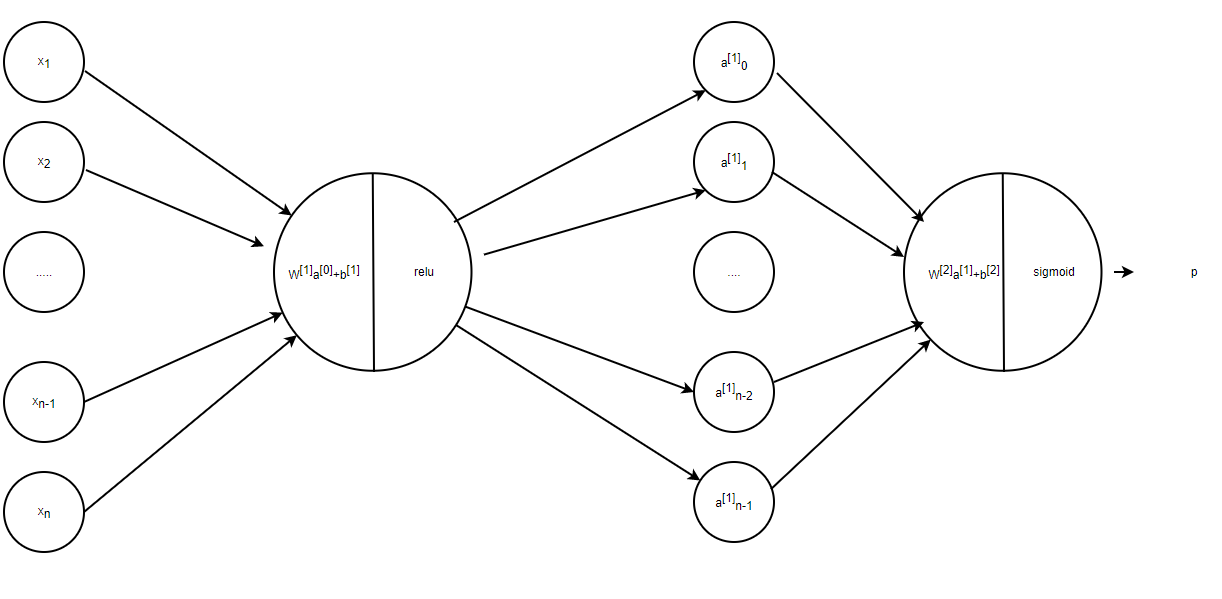
我们正式开始构建两层的神经网络:
def two_layer_model(X,Y,layers_dims,learning_rate=0.0075,num_iterations=3000,print_cost=False,isPlot=True): """ 实现一个两层的神经网络,【LINEAR->RELU】 -> 【LINEAR->SIGMOID】 参数: X - 输入的数据,维度为(n_x,例子数) Y - 标签,向量,0为非猫,1为猫,维度为(1,数量) layers_dims - 层数的向量,维度为(n_y,n_h,n_y) learning_rate - 学习率 num_iterations - 迭代的次数 print_cost - 是否打印成本值,每100次打印一次 isPlot - 是否绘制出误差值的图谱 返回: parameters - 一个包含W1,b1,W2,b2的字典变量 """ np.random.seed(1) grads = {} costs = [] (n_x,n_h,n_y) = layers_dims """ 初始化参数 """ parameters = initialize_parameters(n_x, n_h, n_y) W1 = parameters["W1"] b1 = parameters["b1"] W2 = parameters["W2"] b2 = parameters["b2"] """ 开始进行迭代 """ for i in range(0,num_iterations): #前向传播 A1, cache1 = linear_activation_forward(X, W1, b1, "relu") A2, cache2 = linear_activation_forward(A1, W2, b2, "sigmoid") #计算成本 cost = compute_cost(A2,Y) #后向传播 ##初始化后向传播 dA2 = - (np.divide(Y, A2) - np.divide(1 - Y, 1 - A2)) ##向后传播,输入:“dA2,cache2,cache1”。 输出:“dA1,dW2,db2;还有dA0(未使用),dW1,db1”。 dA1, dW2, db2 = linear_activation_backward(dA2, cache2, "sigmoid") dA0, dW1, db1 = linear_activation_backward(dA1, cache1, "relu") ##向后传播完成后的数据保存到grads grads["dW1"] = dW1 grads["db1"] = db1 grads["dW2"] = dW2 grads["db2"] = db2 #更新参数 parameters = update_parameters(parameters,grads,learning_rate) W1 = parameters["W1"] b1 = parameters["b1"] W2 = parameters["W2"] b2 = parameters["b2"] #打印成本值,如果print_cost=False则忽略 if i % 100 == 0: #记录成本 costs.append(cost) #是否打印成本值 if print_cost: print("第", i ,"次迭代,成本值为:" ,np.squeeze(cost)) #迭代完成,根据条件绘制图 if isPlot: plt.plot(np.squeeze(costs)) plt.ylabel('cost') plt.xlabel('iterations (per tens)') plt.title("Learning rate =" + str(learning_rate)) plt.show() #返回parameters return parameters
train_set_x_orig , train_set_y , test_set_x_orig , test_set_y , classes = lr_utils.load_dataset() train_x_flatten = train_set_x_orig.reshape(train_set_x_orig.shape[0], -1).T test_x_flatten = test_set_x_orig.reshape(test_set_x_orig.shape[0], -1).T train_x = train_x_flatten / 255 train_y = train_set_y test_x = test_x_flatten / 255 test_y = test_set_y
数据集加载完成,开始正式训练:
n_x = 12288 n_h = 7 n_y = 1 layers_dims = (n_x,n_h,n_y) parameters = two_layer_model(train_x, train_set_y, layers_dims = (n_x, n_h, n_y), num_iterations = 2500, print_cost=True,isPlot=True)
第 0 次迭代,成本值为: 0.6930497356599891 第 100 次迭代,成本值为: 0.6464320953428849 第 200 次迭代,成本值为: 0.6325140647912677 第 300 次迭代,成本值为: 0.6015024920354665 第 400 次迭代,成本值为: 0.5601966311605748 第 500 次迭代,成本值为: 0.515830477276473 第 600 次迭代,成本值为: 0.47549013139433266 第 700 次迭代,成本值为: 0.4339163151225749 第 800 次迭代,成本值为: 0.400797753620389 第 900 次迭代,成本值为: 0.3580705011323798 第 1000 次迭代,成本值为: 0.3394281538366412 第 1100 次迭代,成本值为: 0.30527536361962637 第 1200 次迭代,成本值为: 0.27491377282130186 第 1300 次迭代,成本值为: 0.2468176821061483 第 1400 次迭代,成本值为: 0.19850735037466102 第 1500 次迭代,成本值为: 0.1744831811255663 第 1600 次迭代,成本值为: 0.17080762978097416 第 1700 次迭代,成本值为: 0.11306524562164691 第 1800 次迭代,成本值为: 0.09629426845937152 第 1900 次迭代,成本值为: 0.08342617959726865 第 2000 次迭代,成本值为: 0.07439078704319084 第 2100 次迭代,成本值为: 0.06630748132267936 第 2200 次迭代,成本值为: 0.05919329501038171 第 2300 次迭代,成本值为: 0.05336140348560559 第 2400 次迭代,成本值为: 0.04855478562877018
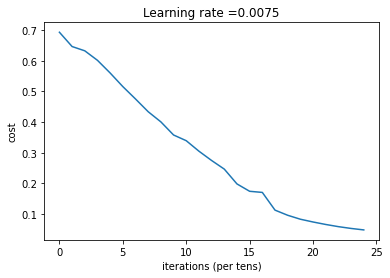
迭代完成之后我们就可以进行预测了,预测函数如下:
def predict(X, y, parameters): """ 该函数用于预测L层神经网络的结果,当然也包含两层 参数: X - 测试集 y - 标签 parameters - 训练模型的参数 返回: p - 给定数据集X的预测 """ m = X.shape[1] n = len(parameters) // 2 # 神经网络的层数 p = np.zeros((1,m)) #根据参数前向传播 probas, caches = L_model_forward(X, parameters) for i in range(0, probas.shape[1]): if probas[0,i] > 0.5: p[0,i] = 1 else: p[0,i] = 0 print("准确度为: " + str(float(np.sum((p == y))/m))) return p
预测函数构建好了我们就开始预测,查看训练集和测试集的准确性:
predictions_train = predict(train_x, train_y, parameters) #训练集 predictions_test = predict(test_x, test_y, parameters) #测试集
准确度为: 1.0 准确度为: 0.72
搭建多层神经网络
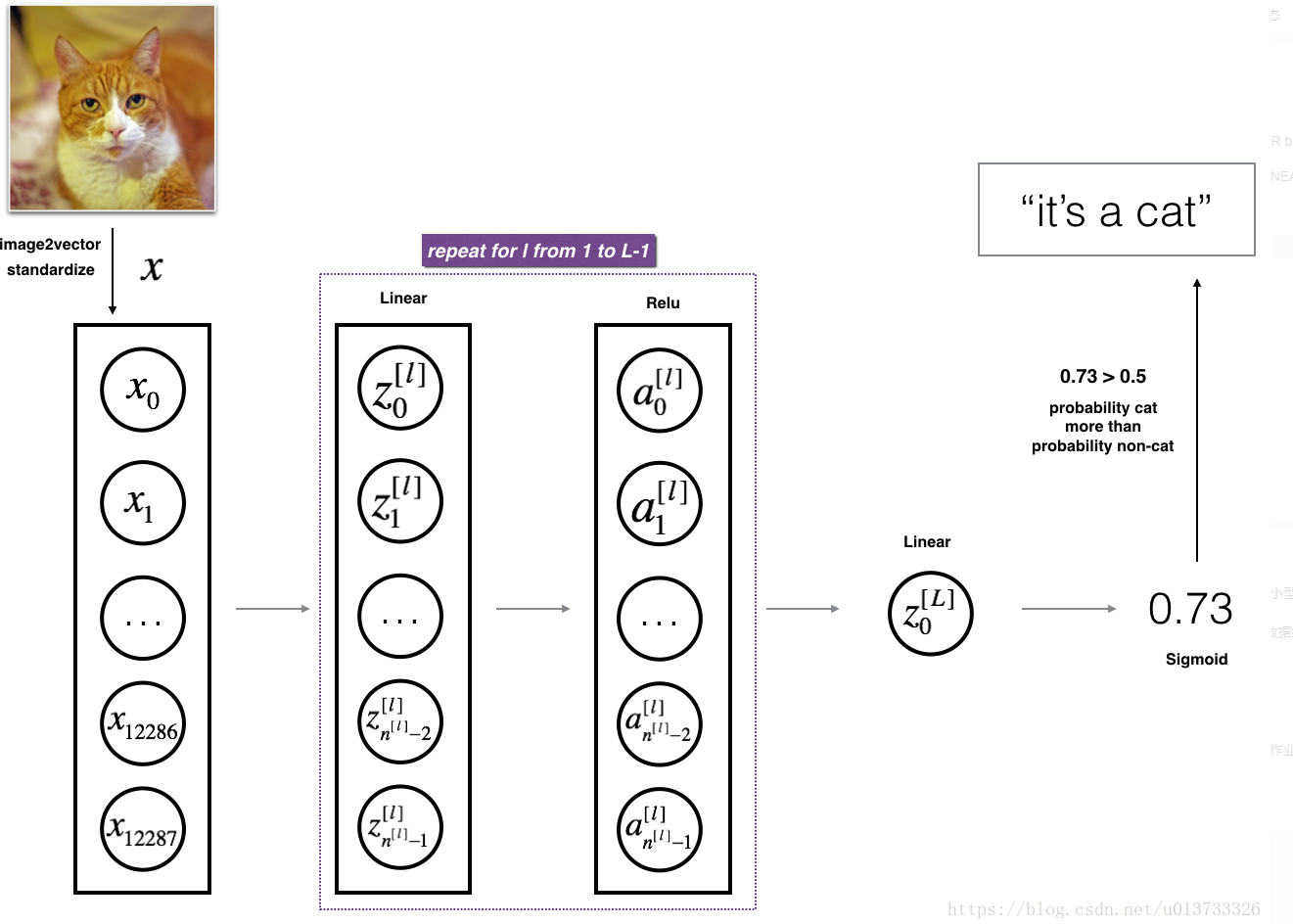
def L_layer_model(X, Y, layers_dims, learning_rate=0.0075, num_iterations=3000, print_cost=False,isPlot=True): """ 实现一个L层神经网络:[LINEAR-> RELU] *(L-1) - > LINEAR-> SIGMOID。 参数: X - 输入的数据,维度为(n_x,例子数) Y - 标签,向量,0为非猫,1为猫,维度为(1,数量) layers_dims - 层数的向量,维度为(n_y,n_h,···,n_h,n_y) learning_rate - 学习率 num_iterations - 迭代的次数 print_cost - 是否打印成本值,每100次打印一次 isPlot - 是否绘制出误差值的图谱 返回: parameters - 模型学习的参数。 然后他们可以用来预测。 """ np.random.seed(1) costs = [] parameters = initialize_parameters_deep(layers_dims) for i in range(0,num_iterations): AL , caches = L_model_forward(X,parameters) cost = compute_cost(AL,Y) grads = L_model_backward(AL,Y,caches) parameters = update_parameters(parameters,grads,learning_rate) #打印成本值,如果print_cost=False则忽略 if i % 100 == 0: #记录成本 costs.append(cost) #是否打印成本值 if print_cost: print("第", i ,"次迭代,成本值为:" ,np.squeeze(cost)) #迭代完成,根据条件绘制图 if isPlot: plt.plot(np.squeeze(costs)) plt.ylabel('cost') plt.xlabel('iterations (per tens)') plt.title("Learning rate =" + str(learning_rate)) plt.show() return parameters
我们现在开始加载数据集:
train_set_x_orig , train_set_y , test_set_x_orig , test_set_y , classes = lr_utils.load_dataset() train_x_flatten = train_set_x_orig.reshape(train_set_x_orig.shape[0], -1).T test_x_flatten = test_set_x_orig.reshape(test_set_x_orig.shape[0], -1).T train_x = train_x_flatten / 255 train_y = train_set_y test_x = test_x_flatten / 255 test_y = test_set_y
数据集加载完成,开始正式训练:
layers_dims = [12288, 20, 7, 5, 1] # 5-layer model parameters = L_layer_model(train_x, train_y, layers_dims, num_iterations = 2500, print_cost = True,isPlot=True)
def print_mislabeled_images(classes, X, y, p): """ 绘制预测和实际不同的图像。 X - 数据集 y - 实际的标签 p - 预测 """ a = p + y mislabeled_indices = np.asarray(np.where(a == 1)) plt.rcParams['figure.figsize'] = (40.0, 40.0) # set default size of plots num_images = len(mislabeled_indices[0]) for i in range(num_images): index = mislabeled_indices[1][i] plt.subplot(2, num_images, i + 1) plt.imshow(X[:,index].reshape(64,64,3), interpolation='nearest') plt.axis('off') plt.title("Prediction: " + classes[int(p[0,index])].decode("utf-8") + " \n Class: " + classes[y[0,index]].decode("utf-8")) print_mislabeled_images(classes, test_x, test_y, pred_test)
 分析一下我们就可以得知原因了:
分析一下我们就可以得知原因了:
模型往往表现欠佳的几种类型的图像包括:
- 猫身体在一个不同的位置
- 猫出现在相似颜色的背景下
- 不同的猫的颜色和品种
- 相机角度
- 图片的亮度
- 比例变化(猫的图像非常大或很小)
相关库代码
lr_utils.py
# lr_utils.py import numpy as np import h5py def load_dataset(): train_dataset = h5py.File('datasets/train_catvnoncat.h5', "r") train_set_x_orig = np.array(train_dataset["train_set_x"][:]) # your train set features train_set_y_orig = np.array(train_dataset["train_set_y"][:]) # your train set labels test_dataset = h5py.File('datasets/test_catvnoncat.h5', "r") test_set_x_orig = np.array(test_dataset["test_set_x"][:]) # your test set features test_set_y_orig = np.array(test_dataset["test_set_y"][:]) # your test set labels classes = np.array(test_dataset["list_classes"][:]) # the list of classes train_set_y_orig = train_set_y_orig.reshape((1, train_set_y_orig.shape[0])) test_set_y_orig = test_set_y_orig.reshape((1, test_set_y_orig.shape[0])) return train_set_x_orig, train_set_y_orig, test_set_x_orig, test_set_y_orig, classes
dnn_utils.py
# dnn_utils.py import numpy as np def sigmoid(Z): """ Implements the sigmoid activation in numpy Arguments: Z -- numpy array of any shape Returns: A -- output of sigmoid(z), same shape as Z cache -- returns Z as well, useful during backpropagation """ A = 1/(1+np.exp(-Z)) cache = Z return A, cache def sigmoid_backward(dA, cache): """ Implement the backward propagation for a single SIGMOID unit. Arguments: dA -- post-activation gradient, of any shape cache -- 'Z' where we store for computing backward propagation efficiently Returns: dZ -- Gradient of the cost with respect to Z """ Z = cache s = 1/(1+np.exp(-Z)) dZ = dA * s * (1-s) assert (dZ.shape == Z.shape) return dZ def relu(Z): """ Implement the RELU function. Arguments: Z -- Output of the linear layer, of any shape Returns: A -- Post-activation parameter, of the same shape as Z cache -- a python dictionary containing "A" ; stored for computing the backward pass efficiently """ A = np.maximum(0,Z) assert(A.shape == Z.shape) cache = Z return A, cache def relu_backward(dA, cache): """ Implement the backward propagation for a single RELU unit. Arguments: dA -- post-activation gradient, of any shape cache -- 'Z' where we store for computing backward propagation efficiently Returns: dZ -- Gradient of the cost with respect to Z """ Z = cache dZ = np.array(dA, copy=True) # just converting dz to a correct object. # When z <= 0, you should set dz to 0 as well. dZ[Z <= 0] = 0 assert (dZ.shape == Z.shape) return dZ
testCase.py
#testCase.py import numpy as np def linear_forward_test_case(): np.random.seed(1) A = np.random.randn(3,2) W = np.random.randn(1,3) b = np.random.randn(1,1) return A, W, b def linear_activation_forward_test_case(): np.random.seed(2) A_prev = np.random.randn(3,2) W = np.random.randn(1,3) b = np.random.randn(1,1) return A_prev, W, b def L_model_forward_test_case(): np.random.seed(1) X = np.random.randn(4,2) W1 = np.random.randn(3,4) b1 = np.random.randn(3,1) W2 = np.random.randn(1,3) b2 = np.random.randn(1,1) parameters = {"W1": W1, "b1": b1, "W2": W2, "b2": b2} return X, parameters def compute_cost_test_case(): Y = np.asarray([[1, 1, 1]]) aL = np.array([[.8,.9,0.4]]) return Y, aL def linear_backward_test_case(): np.random.seed(1) dZ = np.random.randn(1,2) A = np.random.randn(3,2) W = np.random.randn(1,3) b = np.random.randn(1,1) linear_cache = (A, W, b) return dZ, linear_cache def linear_activation_backward_test_case(): np.random.seed(2) dA = np.random.randn(1,2) A = np.random.randn(3,2) W = np.random.randn(1,3) b = np.random.randn(1,1) Z = np.random.randn(1,2) linear_cache = (A, W, b) activation_cache = Z linear_activation_cache = (linear_cache, activation_cache) return dA, linear_activation_cache def L_model_backward_test_case(): np.random.seed(3) AL = np.random.randn(1, 2) Y = np.array([[1, 0]]) A1 = np.random.randn(4,2) W1 = np.random.randn(3,4) b1 = np.random.randn(3,1) Z1 = np.random.randn(3,2) linear_cache_activation_1 = ((A1, W1, b1), Z1) A2 = np.random.randn(3,2) W2 = np.random.randn(1,3) b2 = np.random.randn(1,1) Z2 = np.random.randn(1,2) linear_cache_activation_2 = ( (A2, W2, b2), Z2) caches = (linear_cache_activation_1, linear_cache_activation_2) return AL, Y, caches def update_parameters_test_case(): np.random.seed(2) W1 = np.random.randn(3,4) b1 = np.random.randn(3,1) W2 = np.random.randn(1,3) b2 = np.random.randn(1,1) parameters = {"W1": W1, "b1": b1, "W2": W2, "b2": b2} np.random.seed(3) dW1 = np.random.randn(3,4) db1 = np.random.randn(3,1) dW2 = np.random.randn(1,3) db2 = np.random.randn(1,1) grads = {"dW1": dW1, "db1": db1, "dW2": dW2, "db2": db2} return parameters, grads
